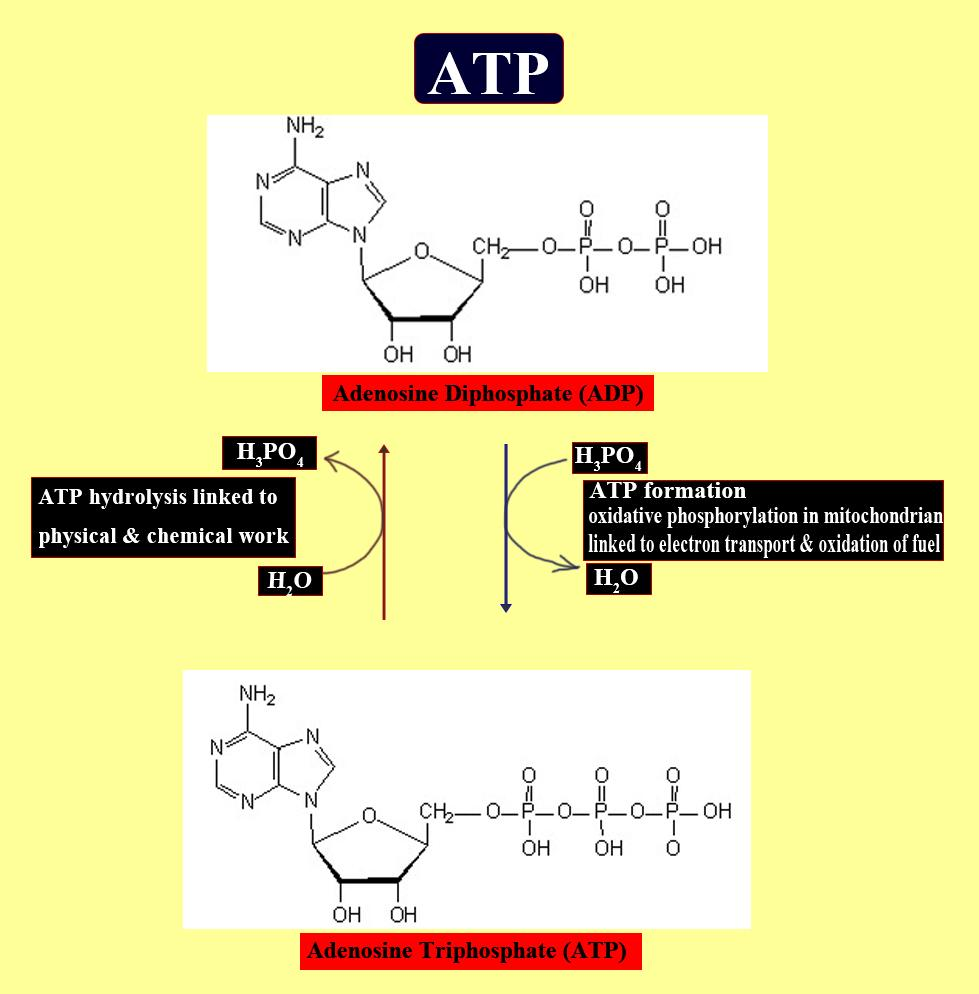
ATP formation occurs through which of the following.
(a) Photophosphorylation
(b) Oxidative phosphorylation
(c) Substrate level phosphorylation
(d) All of these
Answer
480.9k+ views
Hint: The processes that may be involved in the process of photosynthesis, transferring electrons through electron carriers in mitochondria, or converting the higher energy into the lower substrate energy to form ATP.
Complete answer:
The formation of ATP (Adenosine triphosphate) occurs in all three processes as photophosphorylation is the process that occurs during photosynthesis which converts light energy into ATP from ADP. The oxidative phosphorylation is the process of transferring electrons through electron carriers in the mitochondria resulting in the formation of the ATP. Lastly, the substrate- level phosphorylation is the process of conversion of higher energy to lower energy to form ATP.
- The ATP is formed by the help of the ATP synthase enzyme which is used during the process of photosynthesis.
- ATP is the energy currency of the cell which meets the need of the various metabolic reactions that occur during the life cycle of an organism.
- In the process of oxidative phosphorylation, the nutrients are oxidized to produce chemical energy which in turn produces the ATP.
- The oxidative phosphorylation occurs inside the mitochondria that have electron carriers in its inner membrane.
- The substrate level phosphorylation produces a smaller amount of ATP molecules in comparison to other processes, they do not involve mitochondria and electron carriers.

So, the correct answer is ‘All of these’.
Note: The ATP synthase is the enzyme that converts the ADP into ATP and is found mostly in the inner membranes of the cellular organelles like mitochondria and chloroplasts. The process of formation of ATP from ADP and phosphate is known as chemiosmosis. These ATP molecules are required to perform various activities of the cell.
Complete answer:
The formation of ATP (Adenosine triphosphate) occurs in all three processes as photophosphorylation is the process that occurs during photosynthesis which converts light energy into ATP from ADP. The oxidative phosphorylation is the process of transferring electrons through electron carriers in the mitochondria resulting in the formation of the ATP. Lastly, the substrate- level phosphorylation is the process of conversion of higher energy to lower energy to form ATP.
- The ATP is formed by the help of the ATP synthase enzyme which is used during the process of photosynthesis.
- ATP is the energy currency of the cell which meets the need of the various metabolic reactions that occur during the life cycle of an organism.
- In the process of oxidative phosphorylation, the nutrients are oxidized to produce chemical energy which in turn produces the ATP.
- The oxidative phosphorylation occurs inside the mitochondria that have electron carriers in its inner membrane.
- The substrate level phosphorylation produces a smaller amount of ATP molecules in comparison to other processes, they do not involve mitochondria and electron carriers.

So, the correct answer is ‘All of these’.
Note: The ATP synthase is the enzyme that converts the ADP into ATP and is found mostly in the inner membranes of the cellular organelles like mitochondria and chloroplasts. The process of formation of ATP from ADP and phosphate is known as chemiosmosis. These ATP molecules are required to perform various activities of the cell.
Recently Updated Pages
Master Class 11 Accountancy: Engaging Questions & Answers for Success

Express the following as a fraction and simplify a class 7 maths CBSE

The length and width of a rectangle are in ratio of class 7 maths CBSE

The ratio of the income to the expenditure of a family class 7 maths CBSE

How do you write 025 million in scientific notatio class 7 maths CBSE

How do you convert 295 meters per second to kilometers class 7 maths CBSE

Trending doubts
10 examples of friction in our daily life

One Metric ton is equal to kg A 10000 B 1000 C 100 class 11 physics CBSE

Difference Between Prokaryotic Cells and Eukaryotic Cells

State and prove Bernoullis theorem class 11 physics CBSE

What organs are located on the left side of your body class 11 biology CBSE

Write down 5 differences between Ntype and Ptype s class 11 physics CBSE




